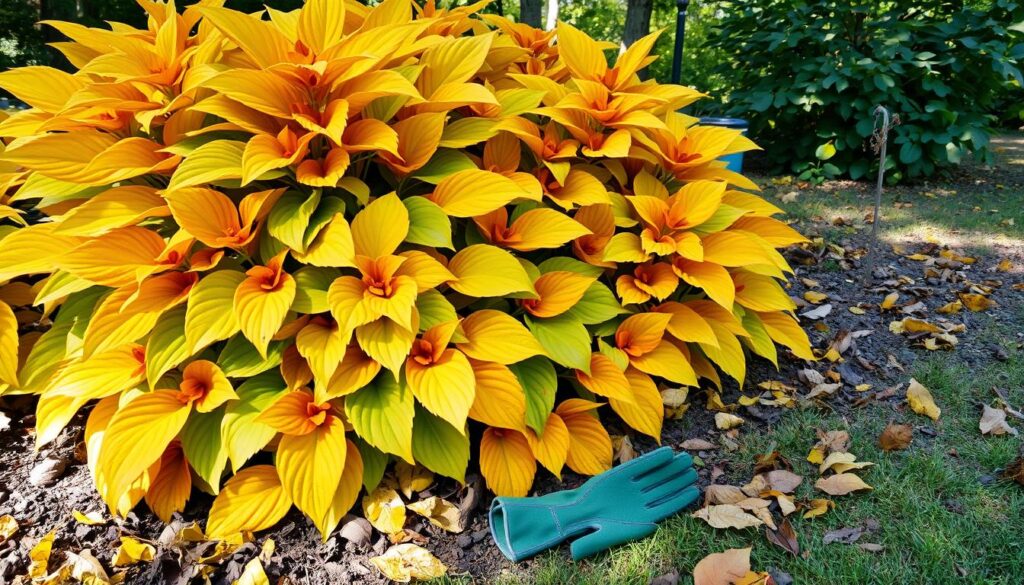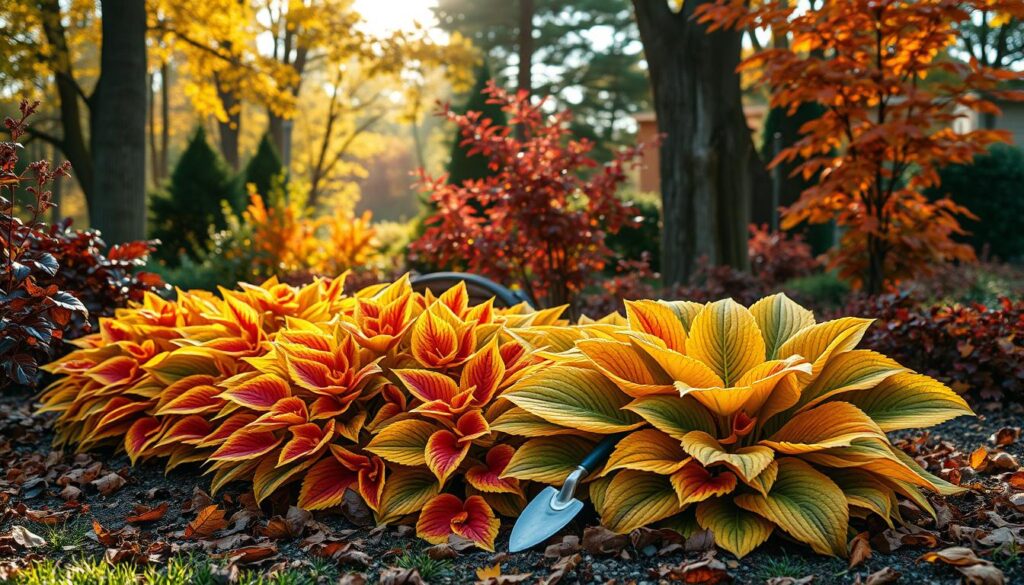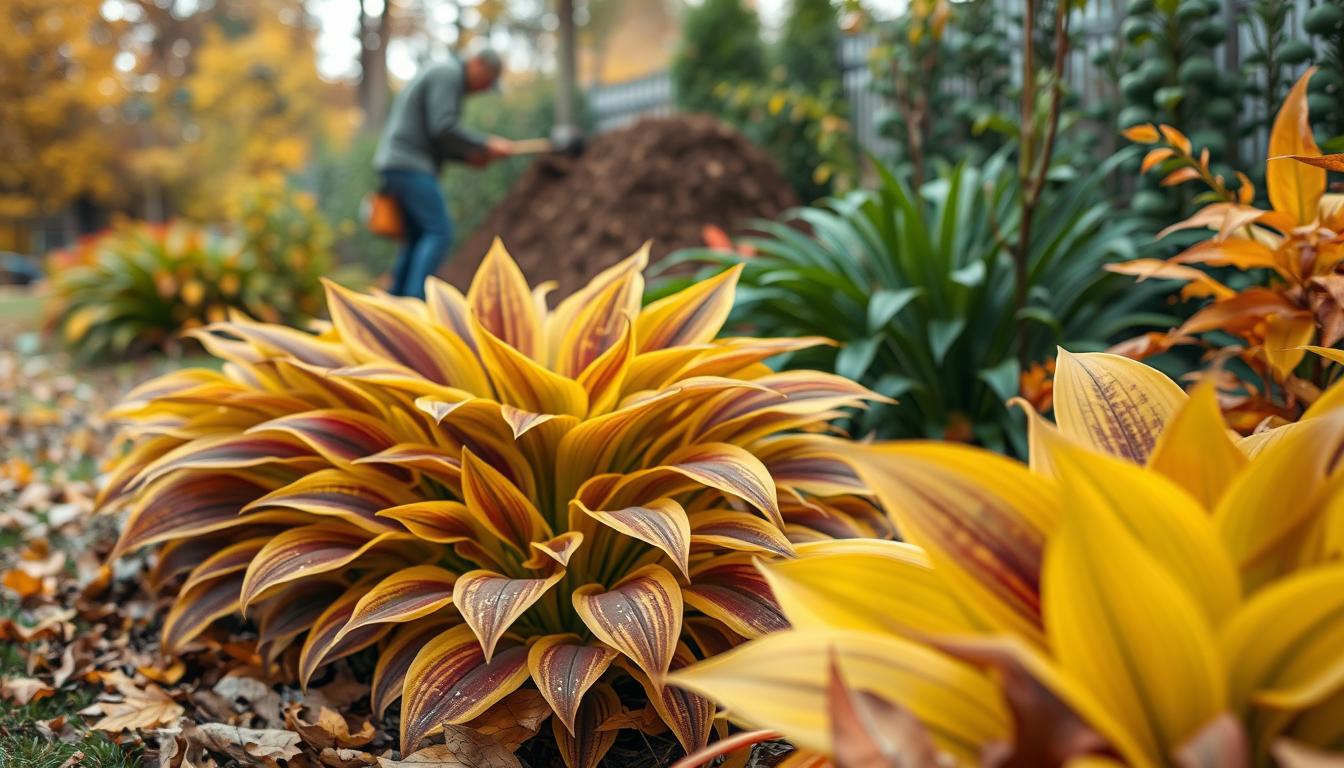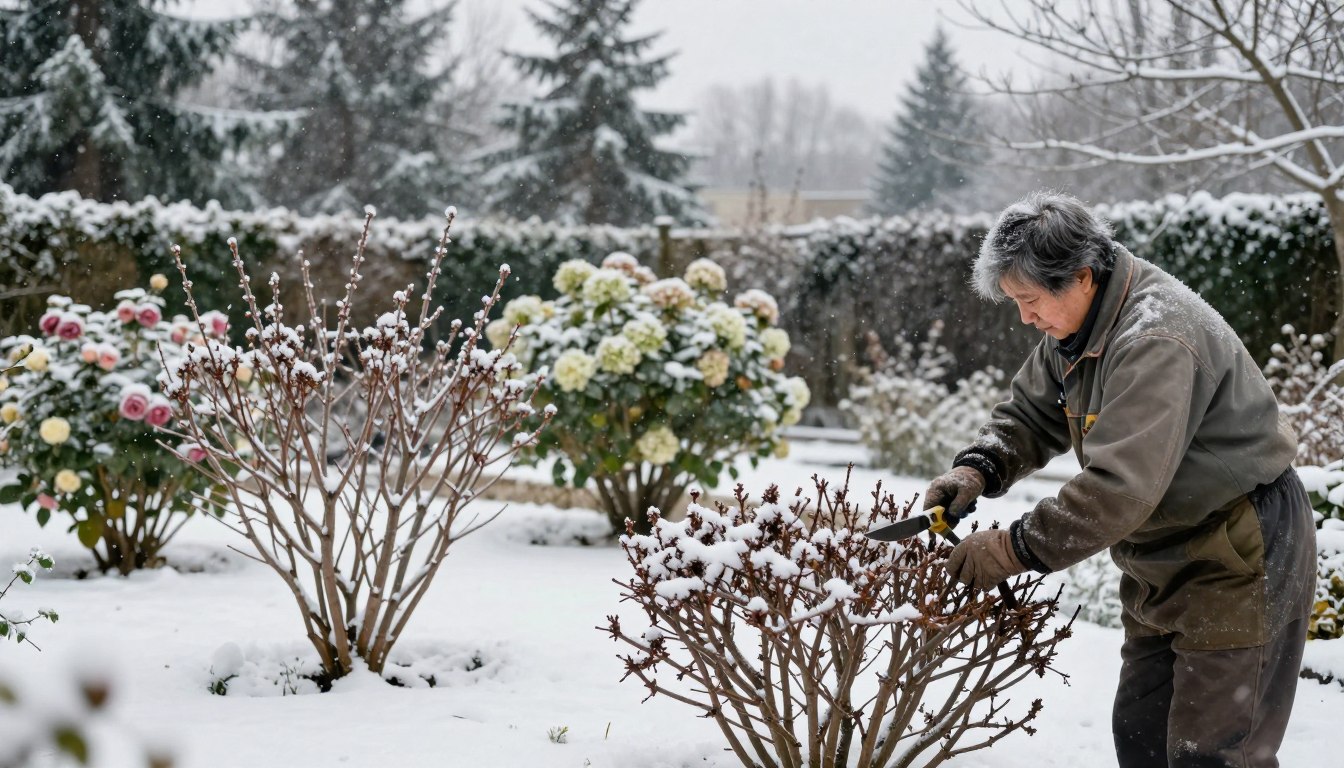Summer’s bright colors fade as autumn’s cooler tones arrive. It’s time to focus on our hosta plants. These perennials add beauty to gardens with their green, blue, and cream colors. But, we must prepare them for winter.
This article will cover the key steps for fall hosta care. We’ll talk about pruning, mulching, and protecting against pests and frost. Follow these tips to keep your hostas healthy through winter and ready for spring.
Key Takeaways
- Hostas need special care in the fall to survive winter.
- Proper pruning, mulching, and pest control are key for winter prep.
- Knowing hostas’ dormancy cycle helps with fall care.
- Protecting hostas from frost, pests, and stress is vital for their health.
- Good fall care sets hostas up for success in the next growing season.
Understanding Hosta Winter Dormancy
As winter gets closer, gardeners see their hosta plants start to wilt. This is normal, part of the hosta’s life cycle called dormancy. Hostas grow well in USDA zones 3-9, showing they can adapt to many climates.
Hostas go dormant in winter, saving energy for spring. A hard freeze tells them to slow down and get ready for cold. Cold weather actually helps hostas grow stronger.
Do Hostas Die Back in Winter?
Even though hosta leaves look dead, the plant is just dormant. It’s saving energy by letting leaves die off. Hostas need 600-700 hours of cold in winter to wake up for spring.
For a smooth transition into dormancy, hostas need the right care before winter. Water in-ground plants well once a month in fall. Potted hostas might need water a few times over winter and can be kept in unheated garages or wrapped up.
Knowing about hosta dormancy and giving them the right care helps them thrive. Even in cold winter months, hostas can stay healthy and beautiful for years.
Fall Hosta Care: To Cut or Not to Cut?
As autumn arrives, hosta lovers wonder if they should trim their plants or not. This choice greatly affects their health through winter.
Leaving the leaves on can protect the plant. They break down, enriching the soil and keeping roots cool in spring. Plus, they keep slugs and snails away.
Trimming the leaves, however, can stop diseases and pests. Early fall is a good time to divide any congested hosta plants. Experts say to cut them down to the ground. Applying a mulch of wood bark can help insulate the plant during the coldest periods of winter.
Whether to cut or not depends on your area’s climate. In places with quick frost, leaving leaves on is better. But in milder climates, removing them is key for hosta autumn preparation and hosta winter readiness.

Fertilize hostas in the springtime with a slow-release fertilizer or a 10-10-10 granular fertilizer. Be careful not to overfertilize, as it can harm the leaves. There are three main pruning times for hostas: Fall, Spring, and Summer. Fall pruning is recommended after leaves are damaged by the first hard frost, typically in September or early October.
When it comes to fall hosta mulching and hostas cold-weather care, the choice is yours. Think about your local climate, your plants’ health, and your preferences to decide what’s best for your hosta garden.
Fall Hosta Care
As the vibrant hosta leaves start to wither and die back in autumn, it’s time for fall care. Whether you choose to cut back the foliage or leave it, there are key steps to take. These steps ensure your hostas are ready for winter.
First, cut the plants down to the soil line once the leaves have wilted. Use sharp garden shears for a clean cut. Discard any diseased or insect-infested foliage to stop problems from spreading. Then, apply a thin layer of mulch, like weed-free straw or pine needles, around the plants. This mulch protects the roots from freeze-thaw damage.
Fall is a great time to divide and transplant mature hosta plants. This process rejuvenates the plants and lets you expand your collection or share with friends. Make sure to add organic matter, like compost or aged manure, to the soil. This enriches the soil and supports strong growth next season.
By pruning, mulching, and dividing your hostas in fall, you prepare them for a strong winter. This ensures they’ll come back lush and vibrant next spring.

“Fall is the perfect time to give your hostas some extra attention and care, setting them up for a strong and healthy comeback in the spring.”
Protecting Hostas in Fall
As the weather cools and days get shorter, it’s time to get your hostas ready for winter. Good fall care and protection will help them come back strong in spring. These shade-loving plants need our help to stay healthy.
Preparing for Pests
Dealing with pests is key in fall hosta care. Hosta nematodes, tiny worms that eat leaves, can be stopped by cutting back foliage. Voles, which burrow around plants, can be kept away by removing leaves.
To keep your hostas safe, use natural repellents like orange peels, eggshells, or coffee grounds. Traps might be needed to control voles. Cleaning up and preparing the hosta bed well will help fight pests and keep your plants healthy come spring.
- Remove hosta foliage to deter nematodes and voles
- Apply natural repellents like orange peels, eggshells, or coffee grounds
- Set traps to control vole populations
- Thoroughly clean and winterize the hosta bed

By taking these steps to fight pests, you’ll help your hostas stay safe and strong for the next growing season.
Conclusion
Follow these fall hosta care tips to help your plants survive winter and grow stronger in spring. Pay attention to your local climate when deciding to cut back foliage or leave it. Also, protect your hostas from pests and extreme weather.
Proper care during winter is crucial for hostas to thrive. Use mulching and understand their hardiness to keep your garden healthy. Focus on autumn care and winter prep for vibrant hostas in the future.
With the right care, your hostas will come back strong next spring. Remember these tips for a beautiful and resilient hosta collection for years.
FAQ
Q: What is the ideal temperature range for hostas during the winter?
A: Hostas need a cold period of 600-700 hours to grow well in spring. This cold helps break down a hormone that makes the plant ready for new growth.
Q: Should I cut back hosta foliage in the fall?
A: There’s a debate on cutting back hosta leaves in fall. Some say it protects the plant and adds nutrients to the soil. Others believe it stops fungal diseases and pests. Your local climate might influence your choice.
Q: How should I protect my hostas during the winter?
A: Cut back the leaves and then mulch with weed-free straw or pine needles. This keeps the roots safe from freezing and thawing. It’s crucial for new hostas to avoid frost heaving.
Q: What pests should I watch out for when caring for hostas in the fall?
A: Watch for hosta nematodes, tiny worms that eat leaves. Cut back foliage to stop them. Also, remove leaf cover to keep voles from making burrows around your plants.
Q: When is the best time to divide and transplant mature hosta plants?
A: Fall is the best time to divide and transplant hostas. It’s also a good time to add compost or aged manure to the soil.






